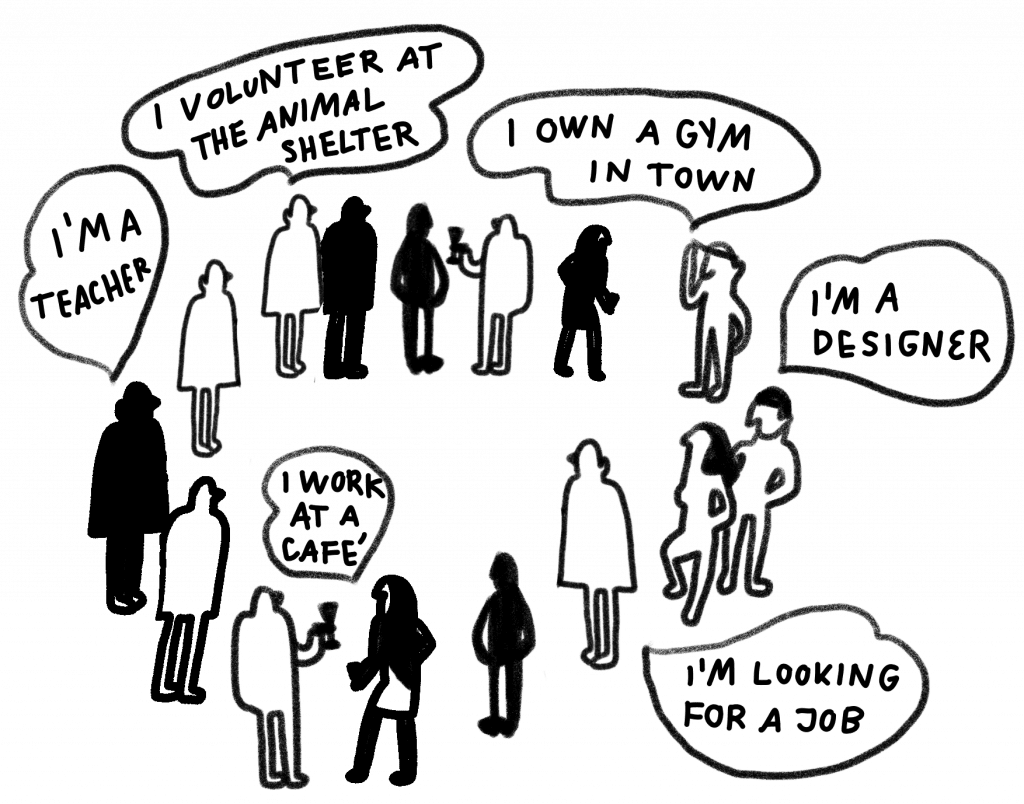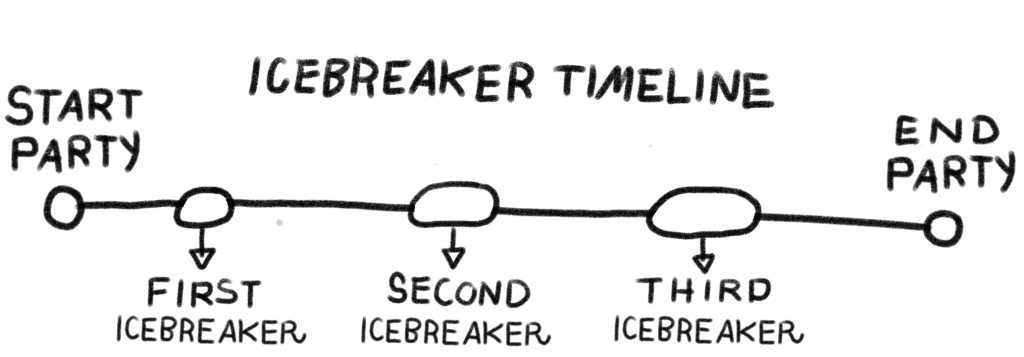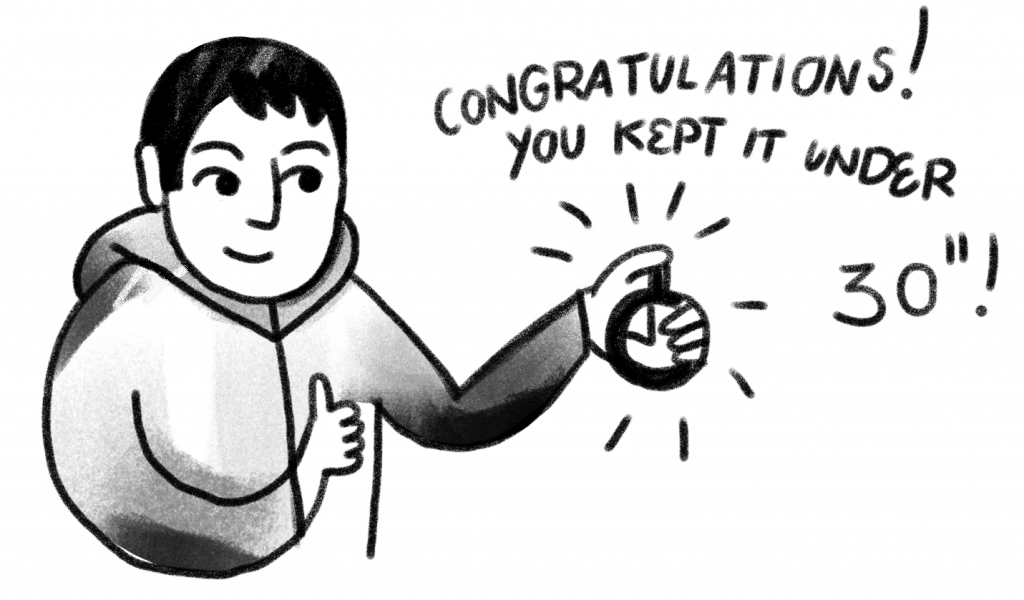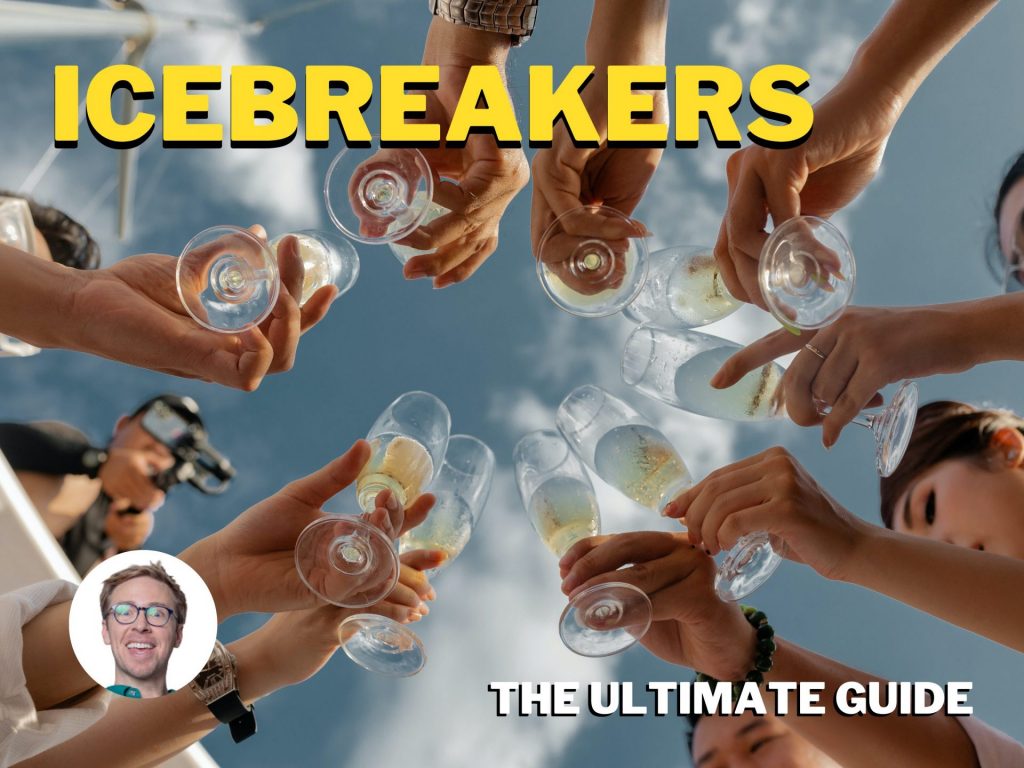Last updated: June 18, 2024
Icebreakers act as a gateway to introductions and help initiate conversations. They allow people to engage in dialogue with ease.
In this article, you’ll discover how to lead a successful icebreaker, create your own icebreakers, and explore some lists of icebreaker questions.
Why you should listen to me: I've hosted hundreds of happy hours and cocktail parties and done icebreakers at every single one. New York Magazine once called me a host of "culturally significant" parties. But don't take their word for it. Keep reading to see my ultimate guide to icebreakers.Lists of Icebreaker Questions
If you want to jump ahead to see a list of icebreaker questions, check out these resources:
- The 36 Best Icebreaker Questions for Work in 2024
- Speed Icebreakers: How to Do Them
- Icebreakers on Name Tags: How to do it RIGHT
- Icebreaker Card Games: Questions & Review of 5 Popular 2023 Decks
Why Icebreakers Work So Well
You’ve likely attended gatherings where you can tell there are plenty of fascinating people present, but you’re not sure who they are or how to engage with them.
You might find yourself wandering around, hoping to stumble upon someone intriguing. Or perhaps you’ve experienced the difficulty of approaching new people or joining ongoing discussions. When the host includes icebreakers, it transforms the experience!
Icebreakers significantly increase the chances of making new connections and sparking conversations.
Short Survey
Good icebreakers are like a short survey where everyone gets to see the results in real-time. Each guest broadcasts who they are and finds out more about the other people present. You get to quickly “meet” and learn about everyone in the room.

How to Use Icebreakers
Icebreakers at your party or event will serve as both an introduction and a conversation starter.
If you’re following my formula from The 2-Hour Cocktail Party, you’ll use them three different times at your party to help your guests create new connections. They’ll take five to ten minutes to complete, and each time, they’ll give your guests an excuse to approach one another.

I know this part sounds tough. Some people are afraid of stopping their party to lead icebreakers. That’s totally normal. You’re going to do fine even if you forget a few of the steps I’m about to discuss.
Icebreakers aren’t a substitute for real conversation. They’re just a shortcut to help your guests feel more comfortable making that first contact.
Once you try out icebreakers at your party, you’ll get the hang of it. Then you’ll never want to host another gathering without them.
Choosing the Right Icebreaker
Not all icebreakers are created equal. People often tell me they love icebreakers only to say that their favorite one is something dramatic like: “What’s your biggest fear?” or “What was the worst date you ever went on?”
Those are terrible icebreakers. They require a deep level of vulnerability and openness. Most people aren’t ready for that at the start of a casual 2-hour cocktail party.
The Icebreaker Structure
Everyone will answer these three questions for each round of icebreakers:
- What’s your name?
- What do you do for work?
- (The icebreaker question)
Stick to simple, fun icebreakers that are quick to answer. Ask your guests to gather in a circle. Have everyone say their name, their profession, and what one of their favorite things is to eat for breakfast.
Some people tell me that icebreakers like this are childish. They say they haven’t done icebreakers since fourth grade, so why should they start now? However, after hosting hundreds of parties, simple icebreakers have helped me warm up the room—every single time.
Starting your party with an icebreaker like the favorite breakfast question works because it gives people a chance to speak in a no-stress, structured format.
Breakfast Is the Icebreaker of Champions
You might still be wondering about the relevance of asking people to name their favorite breakfast food. A simple question like this at the start of your party makes people relatable.
By asking people to talk about their favorite breakfast food, you’re getting them to share something personal that they enjoy in a casual context. Everyone knows what they like to eat for breakfast. It is the most ritualistic of meals. What we eat for breakfast doesn’t define us as people even though it reveals a little bit about our personality.

For example, if one guest says, “Cereal with blueberries and almond milk,” there’s a good chance they’re into healthy eating. Or if someone swears by pancakes and bacon slathered in maple syrup, they might be the person to ask for delicious restaurant recommendations.
I’ve tested this icebreaker extensively. It might sound boring, but it is safe. It works nearly 100 percent of the time for almost 100 percent of guests. It’s practically impossible for it to go wrong and it sets you and your party up for success.
You’ll use this same icebreaker twice: first to practice with your four or five early arrivals, then approximately twenty-five minutes later with the whole party.
Icebreaker Questions to Get to Know Each Other
If you’re determined to vary the “What’s your favorite thing to eat for breakfast?” question, here are three other options:
- What was the first job that you ever got paid to do?
- What was your first online screen name and why did you choose it?
- What’s one of your favorite drinks, with or without alcohol?
I’m only listing three because these are all you need to get started with hosting parties. I’ve used the same beginner icebreaker hundreds of times. I don’t try to use a new one at every party, even if my guests have heard that same icebreaker at my last party.
How to Facilitate the First Icebreaker
It’s the night of your first party. You’re almost out of the Awkward Zone as four or five people have arrived.
Grab your party harmonica because this is the first time that you get to use it. Turn down the music, blow a long note into your harmonica to get the group’s attention, and say something upbeat like this:
OK everybody. What a great group of friends! Let’s come over here to circle up and stand together. You all showed up early or right on time. Thank you for that. You’re great.
Have everyone come together and stand in a circle. Then introduce the first icebreaker:
I want us to go around the circle and do a quick icebreaker so we can get a survey of who’s here. Say your name, what you do for work, and what one of your favorite things to eat for breakfast is. If you don’t want to talk about work, you can say something you’re passionate about instead—like a hobby or charity.
You’ll go first in answering the icebreaker. But first, look to the person to your left or right and ask for their permission to go next in the sequence by saying, “I’ll go first, and then can I go to you?” If they agree, say again:
Great. So, I’ll go first, and then I’ll go to you, and we’ll go around the circle in that same direction.
Clearly outlining how the icebreaker will flow and in which direction will reduce anxiety among introverts and help everyone to be prepared for when it is their turn.
Sample Icebreaker Answer
Now you will go first and set the example for how people should speak their part. My short but juicy answer to the breakfast icebreaker is:
My name is Nick Gray. I’m the Founder of Museum Hack, a company that does renegade museum tours in New York City and at some of the best museums in America. My favorite thing to eat for breakfast is scrambled eggs with spinach, but I have a secret ingredient—I use coconut oil.
By including a bit about my company and a “secret ingredient” in my breakfast answer, I invite others to share more vivid or detailed descriptions. That icebreaker answer takes me twenty-five seconds to say. It is short but not too short.
Answers to icebreakers at your party should be thirty seconds or less. You don’t want your guests to start telling their full life stories just yet.

Start the icebreaker now. You’re going to do great!
What to Do After the Last Person Closes the Icebreaker
Say this to facilitate the transition out of icebreakers:
Thank you. Great job everyone. We just did this icebreaker, and there are great people here and more coming soon. Go make yourself a drink, say hi to someone new, and we’ll do another icebreaker in about twenty minutes.
And then—bingo—that’s it. That’s how your party transitions into and out of your first icebreaker.
Hey, you just did your first round of icebreakers. Nice work! That’s the most complicated thing you’ll ever have to do at a party. But it pays major dividends. And don’t worry if you forget a step or two.
Now the party goes back to people mingling and talking, like what happens at most gatherings. Allow your guests to self-organize for a while in this unstructured time. Think of this moment as confirmation that you’ve survived the Awkward Zone. Congratulations!
How Many Icebreakers and How Often?
Do two beginner icebreakers (same questions) and then one advanced icebreaker at your party. No more, no less. Stop for icebreakers approximately every thirty minutes. Set a timer to remind yourself.
Carry out the first icebreaker with the first four or five people who show up. Twenty minutes later, when most of your guests have arrived, you’ll introduce the same icebreaker again.
Early guests won’t complain about repeating their information in the same icebreaker. They will understand that you are doing it again because there are now more people at your party.
Thirty minutes later, you’ll do one advanced icebreaker that allows your guests to share deeper and strike up even more new conversations.
How Icebreakers Shuffle the Room and Help Guests Circulate
Icebreakers have a hidden feature: they break up conversations.
Have you ever attended a party and found yourself stuck talking to a person that you’re not particularly enjoying? Perhaps you felt it would be rude to end the conversation and walk away.
Well, icebreakers will do that. They give everyone a great reason to move on from a conversation and then chat with someone new.
When you stop your party to do icebreakers, you’ll have to interrupt a few conversations. I remember how nervous I was to do this the first time. I thought: Things are going so well! Everyone is talking. Why would I want to stop their conversations?
Recently, I tested this theory. It was time to do the first round of icebreakers at my party. After gently sounding my party harmonica, I found myself walking up to a high-profile guest who was still engaged in a discussion. I didn’t know him too well, and by interrupting his conversation and inviting him to the icebreaker, I was putting myself at risk of being rejected.
Did I hesitate? Maybe for a few seconds. But I did it. He joined the icebreaker with all the other guests, and it was great.
It reminded me that my job as a host is to shuffle the room and encourage new conversations. If guests want to continue their conversation later, they will. Your loyalty as a host is not to a single guest but to the party as a whole. So be confident when you start your icebreaker and ask everyone to join.
Conclusion
Icebreakers make for a great conversation starter and help your guests meet and know each other better. They are an underrated party essential!
For more articles and exactly which icebreakers you can use, see:
- The 36 Best Icebreaker Questions for Work in 2024
- Speed Icebreakers: How to Do Them
- Icebreakers on Name Tags: How to do it RIGHT
Read my how-to guide, The 2-Hour Cocktail Party, to learn more about how to host your party.
Take a look at this list of questions you can use as icebreakers for your party. Email me at [email protected] if you want to read this chapter from my party hosting handbook.


